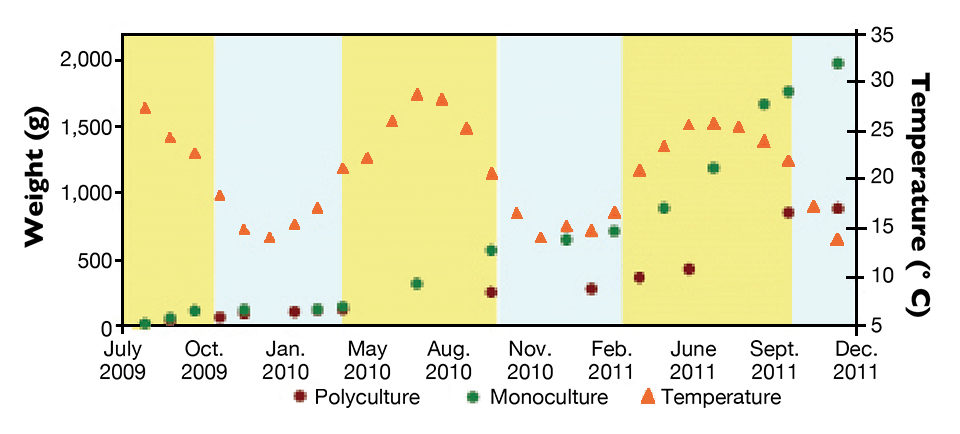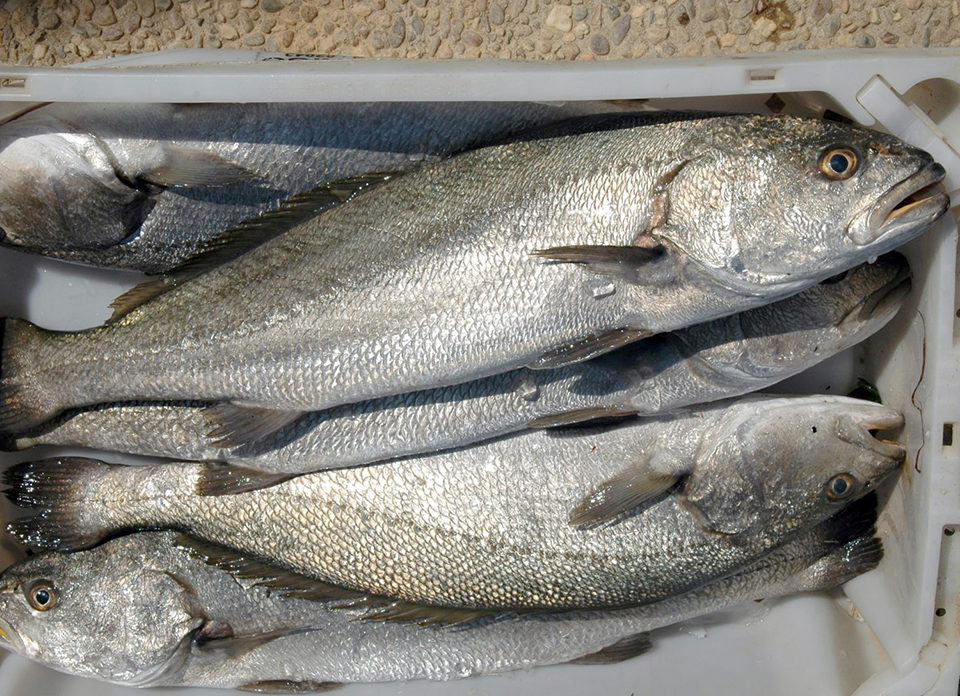Customized feeds will lead to greater performance

The meagre (Argyrosomus regius) is a fast-growing fish species with good feed conversion rates that is a candidate for expanded aquaculture in the Mediterranean. Meagre production started in the late 1990s in France and Italy, but since then has spread to Spain, Egypt, Greece, Turkey, Malta and Portugal. Overall meagre production is still very limited, probably around 5,000 metric tons (MT) total annually, but it is expected to increase.
Meagre production at IPIMAR
Studies to advance meagre production have been undertaken at the Instituto de Investigação das Pescas e do Mar (IPMA) Aquaculture Research Station, a 7-ha marine facility located in Olhão, southern Portugal, for research and technological development of species with potential value for the national aquaculture industry.
Meagre broodstock were initially captured in 2007 and adapted to captivity. The adaption took longer than for other farmed marine fish like sea bream and sea bass. The meagre did not eat for more than three weeks upon capture, and afterwards ate only live mackerel, delaying the introduction of a frozen diet of sardines and squid. From 2009 onwards, five more breeders were captured, but their adaption to captivity was faster.
Meagre broodstock were also more susceptible to external Monogena parasites than other fish species. Altered behavior, such as fish holding their heads above the water surface, and skin darkening were often observed when parasitosis occurred.
Since 2009, the meagre spawn regularly during April and May, 48 hours after hormonal induction at the IPMA facilities. The fish spawn for only one to three days, with the egg volume higher on the first day. When the juvenile stage is attained, the fish are stocked in earthen ponds to evaluate their growth potential.
Pond production
A shorter production cycle and lower investments, as well as a decrease in risk, are expected when farming a fast-growing species. Gilthead sea bream and sea bass normally attain marketable sizes of about 400 g within 12 to 14 months, respectively, when farmed in earthen ponds from 20 grams.
At the IPMA facilities, two farming protocols were used to evaluate meagre growth potential in 3,500-m3 earthen ponds, monoculture and polyculture with S. aurata and Diplodus vulgaris. Fish had a consistent initial weight of 15 g when stocked, but in the monoculture treatment, meagre were pre-fattened in 18-m3 outdoor fiber tanks before being transferred to earthen ponds at 300 g. In the polyculture farming, meagre were directly stocked in the earthen ponds.
The meagre attained 563 ± 170 g (0.5 kg/m3) within 15 months when farmed in monoculture and grew to above 1 kg five months later. When meagre were farmed with sea bream, it took 20 months to attain 300 g (Fig. 1). The differences in fish weight at stocking, as well as the higher levels of water quality, cleaning and access to food in the tanks accounted for the observed differences in growth.

However, meagre feeding behavior and/or the initial stocking size, which was four times smaller than the size of the sea bream in the polyculture ponds, might have contributed to the magnitude of the grow-out weight difference. Sea bream have a more aggressive feeding behavior than meagre, which could have limited access to food for the meagre, especially during the first months.
Further studies with other species and different initial stocking densities are needed to confirm these observations, as well as improvements in feed distribution for greater growth. Increasing the number of meals and/or the number of automatic feeders could be a helpful strategy for the polyculture of meagre with sea bream.

Trial results
Meagre farmed in polyculture and monoculture achieved different average weights after 29 months of grow-out: 879 ± 262.2 grams and 1,968 ± 411.5 grams (Fig. 1), respectively. Differences in growth rates were mainly observed during the first 16 months, after which similar growth rates were observed for both production systems. At IPMA, meagre attained sizes above 1 kg faster than gilthead sea bream and sea bass, which took 45 and 40 months, respectively, to reach 1 kg.
Meagre performance can still be improved, since the fish were fed commercial feeds for sea bream. During the pre-fattening period, feed-conversion ratios of 1.1 were obtained for meagre, suggesting that growth can be enhanced if adequate feed formulations are used. Water temperature greatly affected meagre growth, especially during the winter season.
As expected, the highest specific growth rates – 1.5-2.3 percent/day – were observed during the first 12 months of grow-out. It was also during this period that lower water temperatures had a higher impact on growth (Fig. 1). Two periods of growth could be roughly identified: faster growth during May and October, and slower growth between November and April.
Growth seemed to slow down when water temperatures fell below 22 degrees-C, but meagre feeding behavior was clearly depressed at temperatures below 17 degrees-C. Eating almost stopped below 15 degrees-C, whereas gilthead sea bream feed normally down to 13 degrees-C. Although southern Portugal has a mild winter on the coast, temperatures below 15 degrees-C are registered December through February.
During growout, meagre were more resistant to common diseases affecting other marine fish. At IPMA, the parasites Amyloodinium ocellatum and different Lamelodiscus and Diplectanum species were identified in meagre reared in polyculture, but mortalities were only observed where A. ocellatum was present. The meagre farmed under monoculture were not affected by A. ocellatum, suggesting the sea bream might have been a disease vector.
Although cultured meagre seem less susceptible to diseases than sea bream, sea bass and sole, the intensification of production and/or polyculture with other species may result in disease outbreaks. It is important to follow the basic rules of hygiene and protect fish welfare by controlling density and water quality to prevent such outbreaks.
Market acceptance
Although wild meagre that weigh 8 to 10 kg are common in the markets of southern European countries, where they are typically sold as portions, the taste and nutritional value of this species are unknown to consumers in other countries.
Farmed meagre in 600- to 800-g portion sizes priced below 4€/kg (U.S. $5.33/kg) were not well accepted by consumers due to the darker skin, larger bones and less flesh than those found in meagre above 1 kg. However, studies on portion-size farmed meagre found good overall acceptance by a sensory panel of 20 people.
About 70 percent of the panel moderately liked or very much liked cooked meagre fillets. In relation to sensory attributes, 72 percent of the panel liked slightly to moderately the taste of meagre, while its texture was a less-appreciated attribute. In fact, the fillets were considered somewhat soft – a perception confirmed by instrumental measurements. Nutritionally, the fish were found to have a low fat content in the range of 0.9 to 1.6 percent, but a balanced ratio of omega-3:omega-6 fatty acids.
(Editor’s Note: This article was originally published in the May/June 2013 print edition of the Global Aquaculture Advocate.)
Authors
-
L. Ribeiro
Instituto Portugues do Mar e Atmosfera
Av. 5 de Outubro s/n
8700-305 Olhão, Portugal -
F. Soares
Instituto Portugues do Mar e Atmosfera
Av. 5 de Outubro s/n
8700-305 Olhão, Portugal -
H. Quental-Ferreira
Instituto Portugues do Mar e Atmosfera
Av. 5 de Outubro s/n
8700-305 Olhão, Portugal -
A. Gonçalves
Instituto Portugues do Mar e Atmosfera
Av. 5 de Outubro s/n
8700-305 Olhão, Portugal -
P. Pousão-Ferreira
Instituto Portugues do Mar e Atmosfera
Av. 5 de Outubro s/n
8700-305 Olhão, Portugal
Tagged With
Related Posts

Aquafeeds
A look at phospholipids in aquafeeds
Phospholipids are the major constituents of cell membranes and are vital to the normal function of every cell and organ. The inclusion of phospholipids in aquafeeds ensures increased growth, better survival and stress resistance, and prevention of skeletal deformities of larval and juvenile stages of fish and shellfish species.

Innovation & Investment
At seafood investor forum, a ‘blue-sky’ outlook and a search for the next salmon
At the IntraFish Seafood Investor Forum in New York, “all roads lead to salmon.” Buoyed by high prices and soaring demand, the sector is an example worth following. But it’s not without its challenges.

Aquafeeds
Breaking the 20 percent soy barrier in fish feed
Reduced performance in fish fed high-soy feeds has been blamed on antinutrients, low methionine content and palatability issues. Pretreatment to inactivate anti-nutritional compounds and supplementation with amino acids improves soy-based feed performance, but not to control levels.

Intelligence
Considerations for tilapia farming in saltwater environments
Tilapias are farmed in a variety of production systems, but mostly in freshwater and low-salinity waters. But tilapias are an excellent candidate for aquaculture in brackish- and seawater because they can tolerate a wide range of water salinity.


